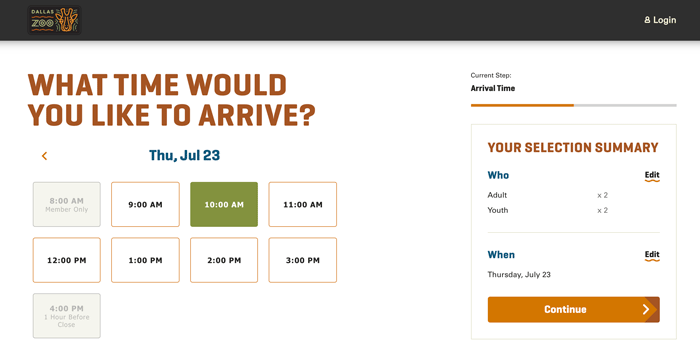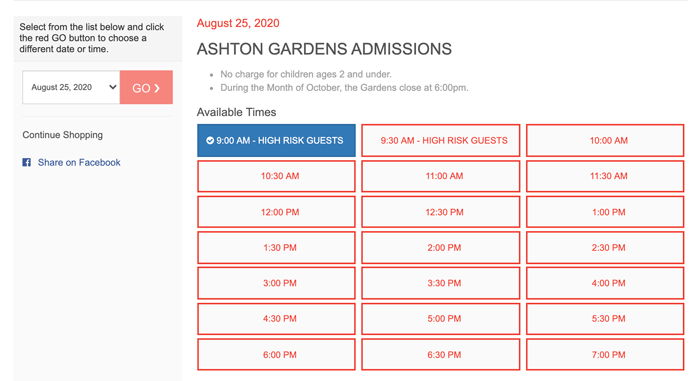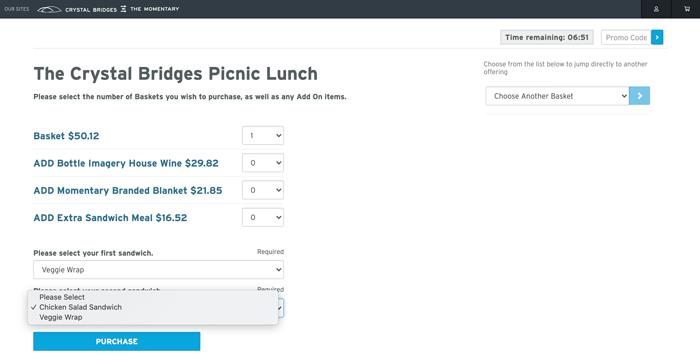Business Strategy
COVID-19
Ticketing and Admissions
Article
Insights & Innovation
77fde417-77c3-4903-b255-1066d5c5b3fc
9 min
https://edge.sitecorecloud.io/tessituraneab9a-tessiturane5642-staging-5396/media/Images/Licensee-Photography/Photos_768x465/crystal_bridges_early_american_gallery-768x465.jpg?h=465&iar=0&w=768
Make every visitor feel safe, and communicate more than ever.
Seven tips for reopening

Director of Marketing & Communications, Tessitura
Seven tips for reopening
7/20/2020
9 min
Reopening looks different for every cultural organization.
But some things should stay the same.
Planning for reopening is full of logistical considerations, from new ticketing and scanning procedures to procuring PPE and maintaining vigilant sanitation. Museums, gardens, zoos, aquariums, and other attractions have a lot to think about before reopening to the public. Technology solutions like timed admission, digital ticketing, contactless payments, member presales, and contactless scanning can all help you meet the challenges posed by the COVID-19 pandemic. Make sure you’re capturing the data you need to strengthen relationships with your members and donors during this daunting time. Furthermore, look for revenue opportunities that can help you build resilience.
Here are seven things you should consider before reopening.
1. Timed admission
Timed admission gives you greater control over the flow of visitors into your venue. The Dallas Zoo reopened at the end of May, first with member preview days and then to the public. The Zoo made the switch to timed admission and required tickets to be purchased in advance online. They also instituted a daily maximum of 2,500 guests, which is less than a quarter of their total capacity.
“As the Dallas Zoo planned for a safe reopen, we knew we had to move to timed admission so we could actively manage capacity throughout the day and avoid crowds at our gates,” says Mark Boyer, Director of CRM and Data Support. “It is fortunate the Dallas Zoo switched to Tessitura a few years ago, and timed admission plus membership benefits are some of the many areas that Tessitura provides as standard. We're thrilled that we executed a successful three-day member preview period and segued directly into our public opening with relatively few technical or experiential glitches, given the significant operational changes we implemented.”

Timed admission for the Dallas Zoo
Even before COVID-19, the Crystal Bridges Museum of American Art was using Tessitura’s timed ticketing features for their Kusama room, Frank Lloyd Wright house, and other exhibits. “Timed ticketing is not new to us at all,” says Megan Martin, Director of Advancement Operations. Admission to Crystal Bridges has always been free, and the team simply adapted their existing timed ticketing setup for museum admission. Crystal Bridges also left room for walk-up admission, which they are selling via tablets running Tessitura’s portable web application.
2. Make every potential visitor feel safe
“Safety and comfort are the blockbuster exhibitions of the season,” wrote Scott Stulen, CEO and President of Tulsa’s Philbrook Museum of Art, on Twitter.
Thanksgiving Point in Lehi, Utah, one of the first American venues to reopen, sought guidance and inspiration from seemingly unrelated businesses that had to stay open uninterrupted. “We took several field trips to local businesses” such as Costco, recalls Kendall Wimmer, VP of Operations. “[We] had management walk through some of the things they had done. We brought our guest services staff; we brought our facilities folks. Those kinds of things help to get eyes on how people were doing it right.”

Rolling shields for tour guides at the National World War I Museum and Memorial
It's not just visitors who need to feel safe — it’s your front-line staff as well. At the National World War I Museum and Memorial in Kansas City, Mo., some volunteer tour guides expressed safety concerns around reopening. In response, the museum had vertical rolling shields constructed that the volunteers can take with them as they guide visitors through the museum.
Finally, the more you can offer contactless options, the safer both guests and staff will feel. Make sure your online sales pathway is easy to navigate to minimize onsite ticket sales, and offer mobile and/or print-at-home tickets to complete the contactless experience. On site, touchless payment devices and contactless scanning can also help you increase safety for everyone.
3. Test out your ideas on a smaller pool of visitors.
“We love member preview days,” says Megan Martin of Crystal Bridges. The museum opened in phases: first, says Chief Strategy Officer Jill Wagar, “We did a donor preview where we only allowed one family unit in every 30 minutes. They were spaced out enough that they didn’t see anybody else when they were in the galleries.”
“And then we went into a member preview” at 15% of the museum’s capacity. “It was good practice for us,” Jill says. “We changed a couple of lines in places. But as far as our process goes, we didn't have to change anything” before reopening to the public at 30% capacity.
Thanksgiving Point chose a different approach to phasing in their opening. “We have five total museum venues,” says Mark Peterson, Director of IT. “We have two outdoor venues that we opened first as kind of a test run.” They have since opened all their venues (except for a few specific activities), with specific sanitation practices for high-touch exhibits.
4. Strengthen your membership base.
Many museums and attractions have traditionally relied on tourism for a large part of their visitor base. But with travel limited for an uncertain period of time, the people who visit when you reopen are likely to be overwhelmingly those who live in your area. These local members and visitors will be critical to rebuilding your growth.
“80% of the total tickets right now are coming from our member base,” says Mark of Thanksgiving Point. “It’s huge.” Kendall surmises: “I feel like those members know what we do and are comfortable coming out in the midst of all of this.” It may seem challenging to engage members during COVID-19, but it can be vital from a financial perspective. “In a time like this pandemic,” Kendall says, “a large member base is really helping fund the Institute right now because there’s not a lot of cash-paying visitors.”
Local members and visitors will be critical to rebuilding your growth.
Your operational choices can help build your membership base. For example, requiring guests to purchase tickets in advance allows you to capture contact information that isn’t collected in a typical onsite transaction. Thanksgiving Point is using that data to encourage visitors to convert a ticket purchase into a membership. Before COVID-19, they used to make that offer in person, valid that day only. Now, they send automated emails to make that offer in a physically distant way, with a weeklong redemption window. “That’s something we wouldn’t be able to do if we weren’t collecting that information from the original online sale,” Mark notes.
5. Create new benchmarks.
This is a time for smart measurement. You don’t know what the trajectory of your reopening will be: how many visitors will come back, how many will continue to feel close to your organization, how many will renew their memberships or purchase new ones. How do you forecast when you don’t have a starting point?
“There are no benchmarks yet for reopening,” says Ed Gargiulo, Director of Enterprise Consulting for Tessitura. That means that if you want to understand visitor behavior, purchasing patterns, price sensitivity, and other vitally important information, you need to make a plan to capture the relevant data points. If you start collecting information from the moment you reopen, you will be able to establish a baseline from which to track your growth throughout the recovery process.
There are no benchmarks yet for reopening.
Once you’ve decided what to capture, be sure to monitor trends and adjust your operations as needed. “Now more than ever, you’ll need to be deliberate in determining what you’re going to analyze,” Ed advises. “Monitor it on a daily basis and be nimble to respond to what’s happening and make changes.”
6. Communicate more than ever.
Balancing safety, visitor experience, member loyalty, and other concerns can be a challenge. How do you reassure visitors of the safety measures that you’re taking and make sure they understand the practices that they must follow?
There are more points of communication than you may be thinking of. At Thanksgiving Point, a single website button was able to make a difference. The five-museum campus has set aside the first hour of each day for high-risk visitors. Yet even with highly visible website messaging, too many others still purchased those designated tickets.
So they relabeled the time slot from “9:00 AM” to “9:00 AM High Risk Guests.” Now, a website visitor can’t miss that 9:00 AM is for high-risk individuals. “It immediately changed the guests’ behavior,” Mark noted. “It's been really effective.”

Time slots at Thanksgiving Point
Crystal Bridges used their website’s checkout path for a different angle. “We were able to add a box that guests have to check to acknowledge our safety guidelines,” says Jill. In addition, the museum sends an automated pre-visit email that reinforces the protocol. “And then we have signage when they arrive to the museum,” Jill adds, “so we have this three-point reminder.”
7. Look for revenue opportunities.
While it’s easy to focus on the limitations of reopening during a pandemic, it’s important to look for the new opportunities. Crystal Bridges, for example, has begun selling picnic baskets as a physically distanced dining option. When a customer buys a ticket online, a message in the purchase path suggests a picnic basket add-on. The customer can choose from different types of snacks or lunches and even select their sandwich preferences. An automated report keeps the culinary team informed of all orders.

Picnic lunch available at Crystal Bridges Museum of American Art
The picnic baskets offer a way to boost dining revenue while their on-site restaurant is operating at low capacity. “We’re trying to provide that customer service, and then also get the culinary sales, knowing that we just can’t accommodate everybody in the restaurant,” says Megan.
At Thanksgiving Point, one of the biggest revenue-generating events is their annual tulip festival. This year, the 250,000 tulips bloomed while their doors were closed. Rather than lose the ephemeral blooms, Mark recalls: “We actually ended up cutting the tulips, bunching them, and selling them through Tessitura.” People could purchase a bouquet for themselves or donate the flowers to health care workers. Instead of letting the tulips bloom unseen, they found a new avenue for revenue — and for community generosity.
• • •
In addition to these considerations, it’s essential to stay true to your mission.
The COVID-19 pandemic has brought the mission of every arts and cultural organization into sharp relief. When working through the logistical challenges to reopen, you might start to wonder: why are you going through all this operational trouble to reopen at a drastically reduced capacity?
“One of the reasons why we opened is because we thought people needed art,” says Jill of Crystal Bridges. In other words, people needed what the museum exists to provide. “We knew that coming back to the museum during this time was going to be poignant and important for a lot of people.”
At Thanksgiving Point, “We were terrified opening the venues, what the feedback might be,” Kendall shared. But the feedback has been positive. “My first day in the garden, I ran into an older couple along the path, and they stopped to thank me. And the gentleman just broke down, crying in gratitude and thanking us for opening those gardens. It was really therapeutic to open those gardens.”
These organizations are finding a renewed sense of meaning in being able to open their spaces once again.
Top photo: Visitors enter the Early American Gallery at the Crystal Bridges Museum of Art. Image courtesy of Crystal Bridges Museum of American Art and the Momentary.
Topics
Business Strategy
/COVID-19
/Ticketing & Admissions

Make your on-sales a success
Ticketing & Admissions / Digital / Customer Service / Technology
Eight tips to help you plan for a smooth on-sale

A contactless customer journey with a personal touch
Arts & Culture / Business Strategy / COVID-19 / Technology / Ticketing & Admissions
How Georgia Aquarium creates a visitor-focused experience
